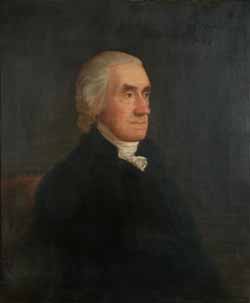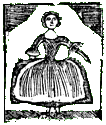A Trial till Half Past One in the Morning
The trial took place in the state’s top court. Chief Justice William Cushing, later a U.S. Supreme Court justice, presided. The prosecutor was attorney general Robert Treat Paine, another former Continental Congress delegate.
The court appointed lawyers for the defendants, who had few connections in town and little money. (Another early example of the tenet that people accused of serious crimes deserve strong legal representation, even if the job might be distasteful.)
It’s possible that each man had his own defense attorney. One was William Tudor, a former clerk of John Adams and the first judge advocate general of the Continental Army.
The other was John Silvester Gardiner (1737-1793), who had quite an interesting career. He was born in Boston, son of the prominent surgeon and apothecary Silvester Gardiner. He went to Scotland for schooling and then built a legal career in London, Wales, St. Kitts, and Paris before returning to Boston in 1783. His father was still exiled from Massachusetts as a Loyalist, but John S. Gardiner was fine with that since they didn’t get along.
Gardiner quickly became one of Boston’s leading attorneys, but he practiced for only a couple of years before souring on the local bar. In 1786 he moved again, to land he inherited in Maine. Soon he won a seat in the Massachusetts General Court and used that as his platform for advocating favorite causes: reforming state law, legalizing theater, making Maine a separate state. He was also influential in turning King’s Chapel Unitarian. In The Gardiners of Massachusetts, T. A. Milford summed up the man’s career (on page 1, yet) by writing, “Gardiner was a pest.”
At the trial, the prosecution’s witnesses told the story I summarized over the last two days. The crucial testimony came from Nero Faneuil, saying he was Archibald and Scott’s accomplice turned state’s evidence.
Then came witnesses for the prisoners—or rather for Scott. Archibald doesn’t seem to have put up much of a defense. Scott and his attorney tried to make the case that he was sleeping somewhere else during the crime. Hannah Nelson testified, “I have seen Scot the Tuesday night before thanksgiving he came to our house lodged all Night.” She recalled giving birth around that time, but couldn’t specify the day. Sarah Bond corroborated Scott’s visit, but then another witness, Abigail Willet, testified that “Sally Bond [had] bad Character.”
The result was a flimsy alibi. Imaginatively, one of the defense attorneys argued, “Mrs. Nelson might have Cook’d up a Story for both as well as one”—i.e., if she was just making up a thin story to save Scott from conviction, why didn’t she claim that both men had been at her house?
Another defense argument was “no part of the Property found on any but Nero,” and “Was it not strange that Nero should be trusted with the money”? In other words, Faneuil might be lying to cast blame on Archibald and Scott. Gardiner might have tried to make that personal; Paine’s notes on the case include the line, “I have known these blks., no credit to be given to them.”
In the end, both Tudor and Gardiner fell back on the position that any doubt in the prosecution’s case should lead the jury to acquit the two defendants, or at least lead the judges to spare them from the death penalty.
According to Paine’s diary, the “Trial ended 1/2 past 1 next morning.” The jury returned a verdict of guilty on capital counts for both Archibald and Scott.
On 9 March, the justices sentenced the two men to hang. The execution finally took place on 5 May. The Massachusetts Spy reported: “They had heretofore behaved in a manner unbecoming their unhappy condition, but on that morning appeared penitent, and suitably affected with their situation.”
What about Nero Faneuil, whose got me into this story? As described back here, he pled guilty to a different robbery and been bound to work for the victim for seven years, or until 1792. He may not have outlived that sentence. Town records show that on 29 July 1792, the Rev. Thomas Baldwin of the Second Baptist Meeting married Flora Fanniel to Magguam Eben.







